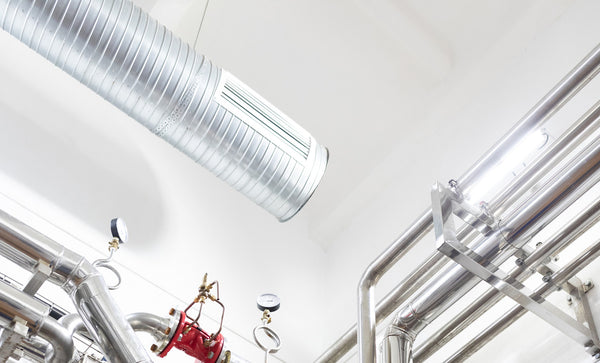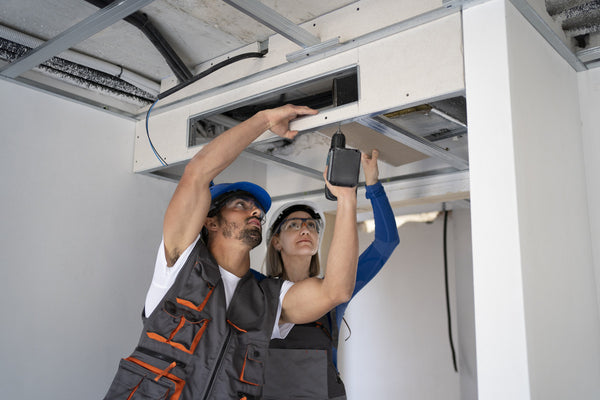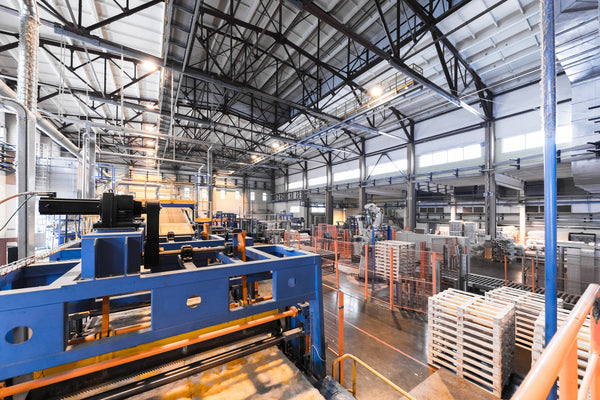Introduction to Flexible Duct Connectors
In the intricate world of HVAC systems, flexible duct connectors play a pivotal role, akin to the shock-absorbing suspension bridges in a bustling city's infrastructure. These connectors ensure that the "traffic" – or air flow – moves smoothly and quietly, without the disruptive "road vibrations" caused by the HVAC equipment reaching the "residents" or the interior spaces of buildings. This guide embarks on a journey through the essentials of flexible duct connectors, shedding light on their significance, the variety of materials available, and offering insights into their selection, installation, and utilization for optimal performance.
The Importance of Flexible Duct Connectors in HVAC Systems

Image by usertrmk on Freepik
Noise and Vibration Isolation
The tranquility of indoor environments hinges significantly on the ability to curb noise and vibrations emanating from HVAC equipment. Flexible duct connectors excel in this domain, serving as a barrier that prevents such disturbances from permeating through the ductwork. This isolation not only enhances the comfort of occupants but also contributes to the durability of the HVAC system by mitigating wear and tear.
Enhancing System Efficiency
Beyond noise reduction, these connectors play a crucial role in maintaining the structural integrity of ductwork. By isolating vibrations, they prevent the formation of leaks, ensuring that air is directed efficiently throughout the system. This efficiency is not just about maintaining comfort but also about conserving energy and reducing operational costs.
Different Materials for Different Needs
Neoprene: The All-Rounder
Neoprene stands out for its versatility, offering a balance of durability, flexibility, and broad chemical resistance. Its adaptability makes it suitable for a wide range of applications, both indoors and outdoors, effectively withstanding various environmental conditions from -35 to 235°F. Whether it's a commercial, industrial, or residential setting, neoprene connectors provide a reliable solution for extending the lifespan and efficiency of HVAC systems.
Vinyl: The Economical Choice
Vinyl connectors represent an economical alternative for indoor applications, particularly in residential settings. As a modern replacement for canvas, vinyl offers a cost-effective solution without compromising on quality. However, its limitation to indoor use, due to lack of UV stability, is a factor worth considering when selecting the right material for your needs.
Hypalon: The UV Champion
For applications exposed to the harsh realities of outdoor environments, Hypalon connectors emerge as the champions of UV resistance. Their ability to withstand direct sunlight without degradation makes them an ideal choice for rooftop units or any HVAC components that face the elements. Hypalon's resilience ensures that your system remains efficient and durable, even under the sun's relentless gaze.
Silicone: For Extreme Temperatures
In scenarios where temperature extremes prevail, silicone connectors are unrivaled. Capable of enduring temperatures ranging from -67 to 500°F, they offer an exceptional solution for high-temperature applications. Silicone's resistance to burning and minimal fume emission upon exposure to flame further underscores its suitability for challenging environments.
The Science Behind the Seams
Double Fold Offset Seam
The double fold offset seam is a testament to the ingenuity behind flexible duct connectors. This design not only protects the fabric during the installation process but also adds rigidity to the connector. The result is a secure, durable fit that stands the test of time, ensuring that the connector remains an integral part of the HVAC system without succumbing to the pressures of installation and operation.
Fab Guard Seam
Elevating fabric protection, the Fab Guard seam encapsulates the fabric within the metal of the seam, safeguarding it from potential damage during installation. This seam is particularly beneficial for installations where durability is paramount, offering peace of mind that the connector will maintain its integrity even in the most demanding conditions.
Installation Mastery

Image by Freepik
Measuring and Cutting
Precision is paramount when installing flexible duct connectors. Accurate measuring and cutting are the first steps toward ensuring a perfect fit, which is crucial for maintaining the efficiency and integrity of the HVAC system. A meticulous approach to this phase of installation can significantly reduce the likelihood of leaks and inefficiencies.
Splicing Techniques
Splicing connectors is an intricate process that demands attention to detail and the use of appropriate materials. Achieving a seamless and leak-free connection between sections of ductwork is essential for the overall performance of the HVAC system. The key to successful splicing lies in the preparation and selection of materials. Firstly, measuring the overlap accurately is crucial. A standard practice involves allowing enough overlap between the connectors to ensure a solid bond without compromising the duct's flexibility. The use of high-quality adhesives designed for HVAC applications is paramount. These adhesives must withstand temperature variations and the rigors of HVAC operations.
Size and Gauge: Tailoring Your Connector
The effectiveness of a flexible duct connector is also influenced by its size and gauge, which should be tailored to the specific requirements of the application. Customizing the size and gauge of your flexible duct connectors according to the specific needs of your application ensures not only the system's optimal performance but also its longevity. This customization process involves assessing the operational environment, the expected load on the ductwork, and the specific requirements of the HVAC system. By tailoring these parameters to fit the unique conditions of each installation, HVAC professionals can guarantee a system that operates at peak efficiency, with enhanced durability and reduced maintenance needs over time.
Packaging Options Explained
Flexible duct connectors come in various packaging options, each with its own set of advantages. Whether it's the compactness of closed packaging, the convenience of open packaging, or the ease of use offered by flat packaging, understanding these options can help in making informed decisions that align with storage, shipping, and installation needs.
Real-World Applications
Indoor Applications
In indoor settings, the primary focus of flexible duct connectors is to minimize noise and vibration. This section will explore various indoor applications, highlighting how connectors can be optimized to enhance the comfort and efficiency of indoor environments.
Outdoor Applications
The challenges posed by outdoor applications require connectors that can withstand environmental factors such as UV exposure and temperature extremes. This section will discuss the selection of materials and designs that ensure the longevity and efficiency of HVAC systems in outdoor settings.
High-Pressure Situations
High-pressure applications demand connectors that can prevent fabric collapse and ensure efficient air flow. The key to addressing high-pressure demands lies in the selection of specially designed connectors. These connectors are engineered with durability and resilience in mind, featuring reinforced materials and construction techniques that withstand the pressures exerted on the ductwork. For instance, connectors equipped with a metal or synthetic reinforcement spine offer added strength, preventing the fabric from succumbing to the forces that can lead to collapse and, subsequently, airflow restriction.

Image by usertrmk on Freepik
Conclusion
Flexible duct connectors are indispensable components of HVAC systems, offering solutions to challenges related to noise, vibration, and efficiency. Understanding the various materials, seams, installation techniques, and applications enables HVAC professionals and enthusiasts to make informed decisions, ensuring systems that are not only quiet and efficient but also durable. As we continue to explore and innovate in the field of HVAC, the evolution of flexible duct connectors remains a testament to the industry's commitment to comfort, efficiency, and sustainability.
FAQs
What is the main purpose of a flexible duct connector?
The main purpose is to isolate noise and vibrations from HVAC equipment, preventing their transmission through the ductwork and enhancing the overall efficiency and comfort of indoor environments.
How do I choose the right material for my flexible duct connector?
The choice depends on the specific needs of your application, including the environment (indoor vs. outdoor), temperature extremes, and chemical exposure. Neoprene is a versatile choice, while vinyl is cost-effective for indoor use, Hypalon offers excellent UV resistance, and silicone is ideal for extreme temperatures.
Can I install a flexible duct connector myself, or should I hire a professional?
While DIY installation is possible with the right tools and knowledge, hiring a professional is recommended for optimal results, especially in complex systems or when dealing with high-pressure applications.
What are the signs that my flexible duct connector needs to be replaced?
Signs include visible wear and tear, leaks, increased noise or vibrations, and a decrease in system efficiency. Regular inspections can help identify these issues early.
How do flexible duct connectors contribute to energy efficiency in HVAC systems?
By ensuring a tight and leak-free connection between the equipment and ductwork, they prevent air loss and reduce the need for the system to work harder to maintain desired temperatures, leading to energy savings.
Image by Freepik





